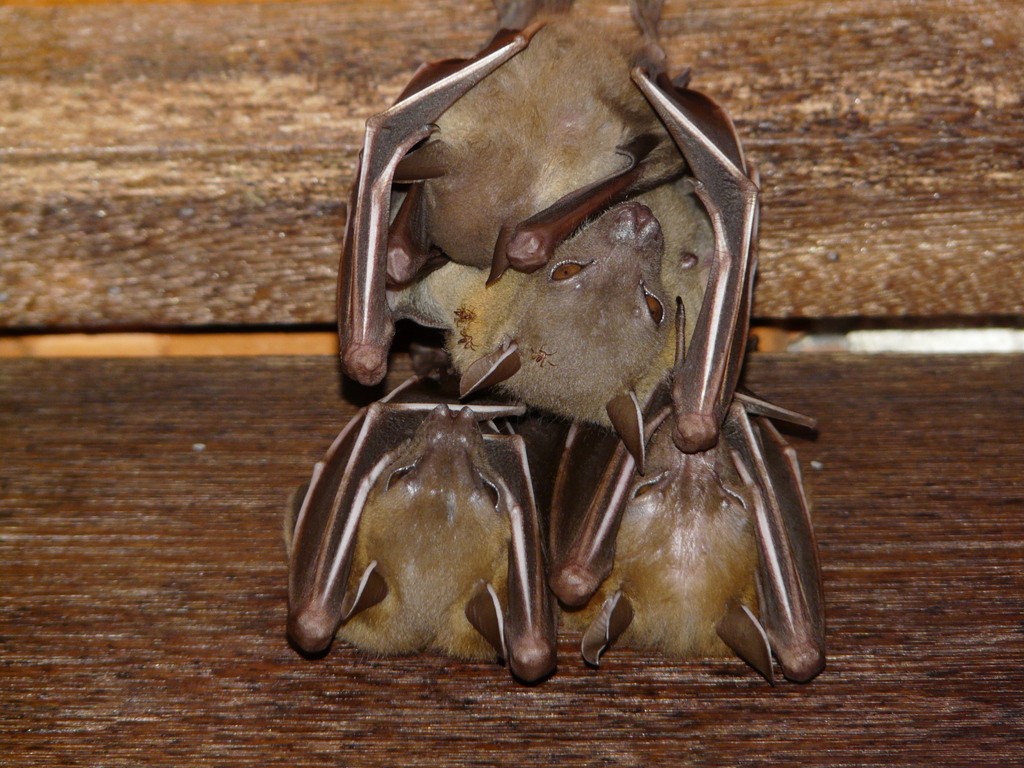Lesser short-nosed fruit bat
A species of Short-nosed fruit bats, Also known as Common short-nosed fruit bat Scientific name : Cynopterus brachyotis Genus : Short-nosed fruit bats
Lesser short-nosed fruit bat, A species of Short-nosed fruit bats
Also known as:
Common short-nosed fruit bat
Botanical name: Cynopterus brachyotis
Genus: Short-nosed fruit bats
Content
Description General Info
Description
Lesser short-nosed fruit bats are generally brown to yellowish brown with a brighter collar. Adult males have dark orange collars whereas adult females have yellowish collars. An indistinct collar is observed in some immature bats. The edges of the ears and the wing bones are usually white. Individuals have two pairs of lower incisors, a fox-like face and large dark eyes. The head and body length is 7–8 cm (2.8–3.1 in), the forearm length is 6–7 cm (2.4–2.8 in), tail length is 0.8–1.0 cm (0.31–0.39 in), and ear length is 1.4–1.6 cm (0.55–0.63 in). There are nine subspecies of lesser short-nosed fruit bat. Corbet and Hill listed 19 alternate names of C. brachyotis, which include: Pachysoma brachyotis, P. duvaucelii, P. brevicaudatum, P. luzoniense, C. grandidieri, C. marginatus var. scherzeri, C. marginatus var. ceylonensis, C. marginatus var. philippensis, C. marginatus var. cuminggii, C. marginatus var. andamanensis, C. brachyoma, C. montanoi, C. minutus, C. minor, C. babi, C. archipelagus and C. nusatenggara. Kitchener and Maharadatunkamsi considered luzoniensis and minutus as separate species while Hill and Thonglongya transferred angulatus to C. sphinx. The lifespan of the lesser short-nosed fruit bat is approximately 20 to 30 years. 
Size
7 - 13 cm
Life Expectancy
5-10 years
Nest Placement
Tree
Feeding Habits
Lesser short-nosed fruit bat primarily consumes a variety of fruits such as mangoes, complemented by nectar and pollen. Lesser short-nosed fruit bat typically forages at night, seeking out aromatic fruits using its keen sense of smell. This species exhibits a unique preference for certain ripe fruits, displaying specialized feeding behaviors that enable efficient fruit consumption.
Habitat
Disturbed forest, lower montane forest, tropical lowland rain forest, plus gardens, mangroves, vegetation on beaches, small groups in trees, under leaves, in caves 
Dite type
Frugivorous
General Info
Feeding Habits
Bird food type

Fruit
Behavior
Lesser short-nosed fruit bat exhibits unusual roosting behaviors, opting for individual leaves rather than caves or trees. With an omnivorous diet, it forages at night for fruits and insects. Notably, it practices resource defense polygyny, where males defend small territories to attract females. While largely solitary, it shows occasional social behavior, especially during reproductive periods.
Distribution Area
The lesser short-nosed fruit bat type specimens were collected from the Dewei River in Borneo on September 12, 1836, and at Naga Cave near Jammut on the Teweh River, Borneo. They are widely distributed in Sri Lanka, southwest and northeast India, Bangladesh, Andaman and Nicobar Islands, southern China, southern Burma, Indochina, Thailand, the Malay Peninsula, Sumatra, Java, Bali, Sulawesi, the Philippines and also on the Lesser Sunda Islands. They are found from sea level up to 1600 m in Borneo. The nominate subspecies, C. b. brachyotis, is distributed in Borneo, Lombok, Peninsular Malaysia, the Philippines and Sulawesi. It is found widespread from sea level to 1,600 meters in altitude. C. b. altitudinis is confined to the highlands of Peninsular Malaysia, from the Cameron Highlands to Gunung Bunga Buah. C. b. brachysoma is found on the Andaman Islands; C. b. cylonensis in Sri Lanka; C. b. concolor in Enggano; C. b. hoffetti in Vietnam; C. b. insularum on the Kangean Islands; C. b. javanicus on Java; and C. b. minutus on Nias. 
Species Status
Lesser short-nosed fruit bats are designated a least-concern species by the International Commission on Zoological Nomenclature (ICZN) because the population is widely distributed, stable and still abundant. Possible threats may be habitat loss due to development, dams, and deforestation. The animals are being hunted for medical purposes, as reported in ICZN 2006. 
Scientific Classification
Phylum
Chordates Class
Mammals Order
Bats Family
Megabats Genus
Short-nosed fruit bats Species
Lesser short-nosed fruit bat 